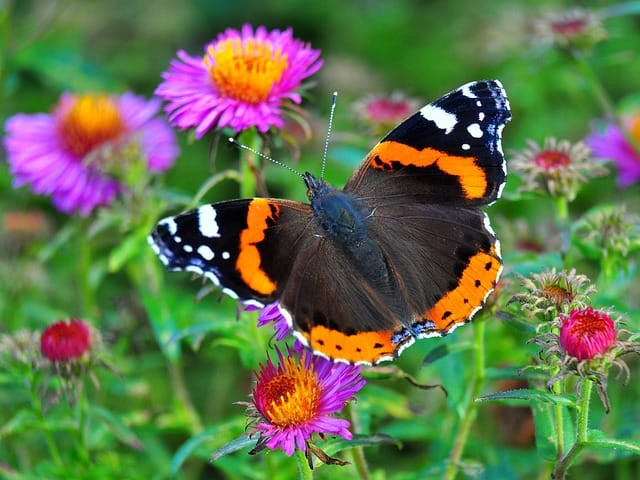Promoting pollinators: Red admirals
The Red Admiral (Vanessa atalanta) is a species of butterfly that plays a crucial role in the ecosystem as a pollinator

In this article:
- Introduction: The Red Admirals Pollinator
- Physical Description and Identification
- Geographic Distribution
- Habitat and Preferred Environments
- Life Cycle: From Egg to Adult
- Diet and Foraging Habits
- Importance as a Pollinator
- Interactions with Plants: Preferred Host Plants and Nectar Sources
- Mating and Reproduction
- Threats and Conservation Status
- Human Interaction and Role
- Interesting Facts and Adaptations
- Conclusion: The Importance of the Red Admirals Pollinator in Ecosystems
Introduction: The Red Admirals Pollinator
The Red Admiral (Vanessa atalanta) is a species of butterfly that plays a crucial role in the ecosystem as a pollinator. These beautiful insects are known for their striking appearance and efficient foraging habits, making them an important part of maintaining biodiversity.
Physical Description and Identification
The Red Admiral butterfly features a dark brown body with distinctive red-orange bands and white spots on its wings. Its wingspan typically ranges from 2 to 3 inches (5 to 7.5 cm). These markings allow for easy identification, making it a popular species among butterfly enthusiasts.
Geographic Distribution
Red Admirals can be found in various regions across the world, including Europe, North America, Asia, and North Africa. They are known for their migratory behavior, with individuals flying hundreds or even thousands of miles to reach suitable breeding grounds.
Habitat and Preferred Environments
Red Admirals thrive in diverse habitats, including woodlands, gardens, parks, and urban areas. They prefer areas with abundant nectar sources and suitable host plants for egg-laying. These butterflies are highly adaptable and can be found in both tropical and temperate climates.
Life Cycle: From Egg to Adult
The life cycle of a Red Admiral butterfly consists of four stages: egg, larva, pupa, and adult. Females lay their eggs on the undersides of leaves of host plants, such as nettles. The larvae hatch within a week and undergo several molts before forming a chrysalis. After about two weeks, adult butterflies emerge to begin the process all over again.
Diet and Foraging Habits
Red Admirals primarily feed on nectar from a range of flowering plants, including asters, milkweed, and thistles. They have a strong preference for fermenting fruit, tree sap, and human-made sugar-rich nutrients. Their long tongues enable them to extract nectar from deep flower tubes, ensuring efficient pollination.
Importance as a Pollinator
Red Admirals are highly effective pollinators due to their frequent visits to flowers in search of nectar. As they move from plant to plant, they unintentionally transfer pollen grains, facilitating cross-pollination. This process helps plants reproduce and results in the production of seeds and fruits.
Interactions with Plants: Preferred Host Plants and Nectar Sources
Nettles (Urtica dioica) are the preferred host plants for Red Admirals, as the female butterflies lay their eggs exclusively on these plant species. As for nectar sources, Red Admirals are attracted to a wide range of flowering plants, including buttercups, daisies, and marigolds.
Mating and Reproduction
Male Red Admirals establish territories and engage in aerial battles to attract females. After mating, the female searches for suitable host plants to lay her eggs. The eggs remain attached to the leaves until they hatch, and the cycle continues.
Threats and Conservation Status
Like many other butterfly species, Red Admirals face various threats, including habitat loss, climate change, pesticide use, and invasive species. The conservation status of Red Admirals varies across different regions, and efforts to protect their habitats and promote sustainable gardening practices are crucial for their conservation.
Human Interaction and Role
Humans play a vital role in promoting the survival of Red Admirals. By planting nectar-rich flowers and creating butterfly-friendly environments in our own gardens, we can attract and support these pollinators. Educating others about the importance of butterflies and their habitats also plays a significant role in their conservation.
Interesting Facts and Adaptations
- Red Admirals are known for their ability to survive in various climates, including extreme cold and high altitudes.
- These butterflies have stronger flight muscles than many other butterfly species, enabling them to fly long distances without fatigue.
- Red Admirals can detect certain chemicals, such as formaldehyde, that are found in fermenting fruits, helping them locate suitable food sources.
Conclusion: The Importance of the Red Admirals Pollinator in Ecosystems
The Red Admiral butterfly plays a crucial role as a pollinator, contributing to the reproduction and survival of numerous plant species. By understanding their life cycle, preferred environments, and the threats they face, we can work towards protecting these beautiful insects and ensuring their presence in our ecosystems for future generations.
